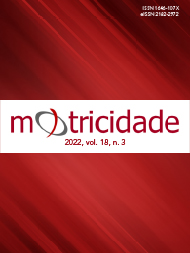Team cohesion and group conflict in Brazilian youth athletes: study based on achievement goals theory
DOI:
https://doi.org/10.6063/motricidade.25937Keywords:
Youth Athletes, Group Environment, Goals, Team Cohesion, Sports PsychologyAbstract
The present study investigated the cohesion of teams and group conflict, based on the theory of compliance goals, in young Brazilian athletes participating in the final phase of the School Games in the state of Pernambuco. The participants were 413 young athletes, boys (n= 227) and girls (n= 186) aged between 14 and 17 years. Participants completed self-report questionnaires to assess the Youth Sport Environment Questionnaire (P-YSEQ), Group Conflict Questionnaire (P-GCQ) and Task and Ego Orientation in Sport Questionnaire (TEOSQ). The data were analyzed using hierarchical and non-hierarchical cluster analysis, chi-square test, multiple regression and multivariate variance analysis (MANOVA). The results showed that task orientation made the largest positive contribution to both task (β= .50, p< .001) and social (β= .31, p< .05) cohesion. Ego orientation made the largest positive contribution to task conflict (β= .49, p< .001) and social conflict (β= .67, p< .001), whilst task orientation made a negative contribution (β= -.34, p< .05) for social conflict. Compared to the high task and low ego cluster (Cluster 3) was compared with low ego and task (Cluster 2) and high task and low ego cluster (Cluster 1), there was a significant difference between groups in task cohesion (p= .001), task conflict (p= .003) and social conflict (p= .001). It is concluded that task orientation seems to be a positive predictor of team cohesion, while ego orientation might predict positively group conflict and negatively task cohesion.
Downloads
Published
Issue
Section
License
The authors of submitted manuscripts must transfer the full copyright to Journal Motricidade / Sílabas Didáticas Editions. Granting copyright permission allows the publication and dissemination of the article in printed or electronic formats, and copyrights start at the moment the manuscript is accepted for publication. It also allows Journal Motricidade to use and commercialise the article in terms of licensing, lending or selling its content to indexation/abstracts databases and other entities.
According to the terms of the Creative Commons licence, authors may reproduce a reasonable number of copies for personal or professional purposes, but without any economic gain. SHERPA/RoMEO allows authors to post a final digital copy (post-printing version) of the article on their websites or on their institutions' scientific repository.


